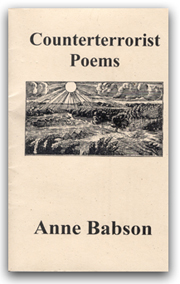
Counterterrorist Poems
Anne Babson
Review by Alyce Wilson
"The truth stings," Anne Babson writes in her poem "Sickle Cell Anemia." But if that's true, in Babson's poems, the sting is tempered by human connection. With delicate craft and rich imagery reminiscent of a Rita Dove, along with the raw earth zen of a Gary Snyder, Babson writes about what so many pundits are calling "the new normal" in the United States.
"Counterterrorist Poems," is dedicated "to all victims of religious extremists," recognizing that the first victims are frequently women.
The chapbook begins with the rubble of the World Trade Center, where "an ashy tickertape cascades from tower to street."
From this meditative eulogy, Babson moves to "Burqua," a poem that compares the strict oppression of fundamentalist extremism to the constricting gender roles of America society. The speaker of the poem at first envies the burqua wearer for the safe space it creates: "The hemlines never rise like the tide going out on a polluted shore, / revealing old spare tires, and varicose veins are kept between / your and your God." But before long, the speaker realizes that, as appealing as it seems to be safe from the leering male gaze, the woman in the burqua is "probably eighteen, innocent / of ideas, willing to obey the man your family saddled / you with".
"Saga of Maha, Princess of Arabia" imagines a Saudi woman who defends herself against assaults and who disguises herself as her brother to go out at night. A woman who will, "pistol in one hand, henna in the other, / become the harem's first warrior mother / and unveil a nation."
From the Middle East, Babson moves to the universal world of childbirth, of mourning, and of healing, bridging the worlds with the tender "Note to My Neighbor," written to an Indian woman who lives in the next building. She imagines bridging the gap by pinning a note to the clothesline and sending it over.
This metaphorical gesture opens the door to imagining other realities: a torturer in an unnamed country, a grocery store bagger, an immigrant arriving at Ellis Island.
And after this tapestry of experience, she brings us back to the World Trade Center, to tell the miraculous story of how her friend escaped the tragedy. How their serendipitous first meeting led to her personal connection to both the tragedy and the joy of one miraculously saved.
The overall effect is a treatise on the power of human connection to overcome painful reality. That connection, Babson suggests, is the most powerful method of counterterrorism there is.
Pudding House Publications; ISBN: 1598891316